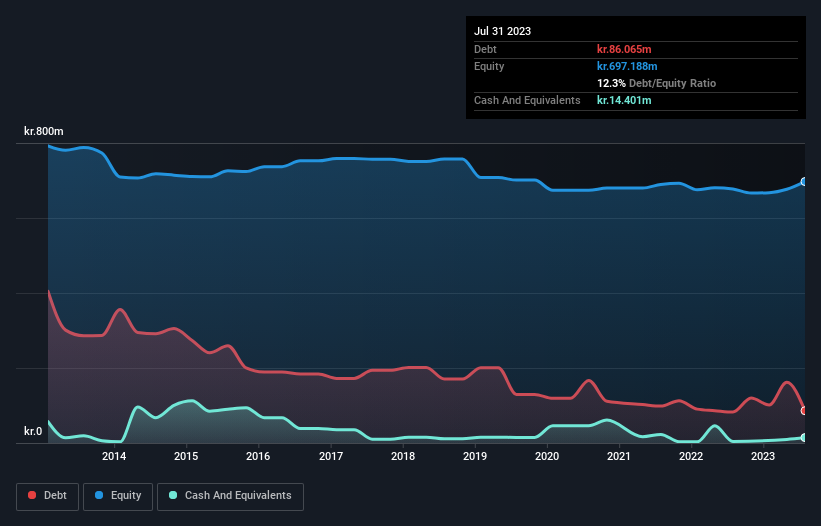
Legendary fund manager Li Lu (who Charlie Munger backed) once said, 'The biggest investment risk is not the volatility of prices, but whether you will suffer a permanent loss of capital.' So it might be obvious that you need to consider debt, when you think about how risky any given stock is, because too much debt can sink a company. As with many other companies Harboes Bryggeri A/S (CPH:HARB B) makes use of debt. But the real question is whether this debt is making the company risky.
When Is Debt Dangerous?
Generally speaking, debt only becomes a real problem when a company can't easily pay it off, either by raising capital or with its own cash flow. If things get really bad, the lenders can take control of the business. However, a more common (but still painful) scenario is that it has to raise new equity capital at a low price, thus permanently diluting shareholders. Of course, debt can be an important tool in businesses, particularly capital heavy businesses. The first step when considering a company's debt levels is to consider its cash and debt together.
Check out our latest analysis for Harboes Bryggeri
What Is Harboes Bryggeri's Debt?
As you can see below, at the end of July 2023, Harboes Bryggeri had kr.86.1m of debt, up from kr.82.4m a year ago. Click the image for more detail. On the flip side, it has kr.14.4m in cash leading to net debt of about kr.71.7m.

How Strong Is Harboes Bryggeri's Balance Sheet?
According to the last reported balance sheet, Harboes Bryggeri had liabilities of kr.363.5m due within 12 months, and liabilities of kr.140.6m due beyond 12 months. On the other hand, it had cash of kr.14.4m and kr.379.2m worth of receivables due within a year. So its liabilities total kr.110.5m more than the combination of its cash and short-term receivables.
While this might seem like a lot, it is not so bad since Harboes Bryggeri has a market capitalization of kr.285.5m, and so it could probably strengthen its balance sheet by raising capital if it needed to. But we definitely want to keep our eyes open to indications that its debt is bringing too much risk.
We use two main ratios to inform us about debt levels relative to earnings. The first is net debt divided by earnings before interest, tax, depreciation, and amortization (EBITDA), while the second is how many times its earnings before interest and tax (EBIT) covers its interest expense (or its interest cover, for short). The advantage of this approach is that we take into account both the absolute quantum of debt (with net debt to EBITDA) and the actual interest expenses associated with that debt (with its interest cover ratio).
While Harboes Bryggeri's low debt to EBITDA ratio of 0.68 suggests only modest use of debt, the fact that EBIT only covered the interest expense by 4.2 times last year does give us pause. So we'd recommend keeping a close eye on the impact financing costs are having on the business. We also note that Harboes Bryggeri improved its EBIT from a last year's loss to a positive kr.31m. The balance sheet is clearly the area to focus on when you are analysing debt. But you can't view debt in total isolation; since Harboes Bryggeri will need earnings to service that debt. So when considering debt, it's definitely worth looking at the earnings trend. Click here for an interactive snapshot.
Finally, a business needs free cash flow to pay off debt; accounting profits just don't cut it. So it's worth checking how much of the earnings before interest and tax (EBIT) is backed by free cash flow. Looking at the most recent year, Harboes Bryggeri recorded free cash flow of 28% of its EBIT, which is weaker than we'd expect. That's not great, when it comes to paying down debt.
Our View
Harboes Bryggeri's conversion of EBIT to free cash flow and interest cover definitely weigh on it, in our esteem. But its net debt to EBITDA tells a very different story, and suggests some resilience. We think that Harboes Bryggeri's debt does make it a bit risky, after considering the aforementioned data points together. Not all risk is bad, as it can boost share price returns if it pays off, but this debt risk is worth keeping in mind. When analysing debt levels, the balance sheet is the obvious place to start. But ultimately, every company can contain risks that exist outside of the balance sheet. Case in point: We've spotted 1 warning sign for Harboes Bryggeri you should be aware of.
If you're interested in investing in businesses that can grow profits without the burden of debt, then check out this free list of growing businesses that have net cash on the balance sheet.
Valuation is complex, but we're here to simplify it.
Discover if Harboes Bryggeri might be undervalued or overvalued with our detailed analysis, featuring fair value estimates, potential risks, dividends, insider trades, and its financial condition.
Access Free AnalysisHave feedback on this article? Concerned about the content? Get in touch with us directly. Alternatively, email editorial-team (at) simplywallst.com.
This article by Simply Wall St is general in nature. We provide commentary based on historical data and analyst forecasts only using an unbiased methodology and our articles are not intended to be financial advice. It does not constitute a recommendation to buy or sell any stock, and does not take account of your objectives, or your financial situation. We aim to bring you long-term focused analysis driven by fundamental data. Note that our analysis may not factor in the latest price-sensitive company announcements or qualitative material. Simply Wall St has no position in any stocks mentioned.
About CPSE:HARB B
Harboes Bryggeri
Develops, produces, and markets beverages and malt-based food ingredients worldwide.
Excellent balance sheet and slightly overvalued.
Market Insights
Community Narratives




